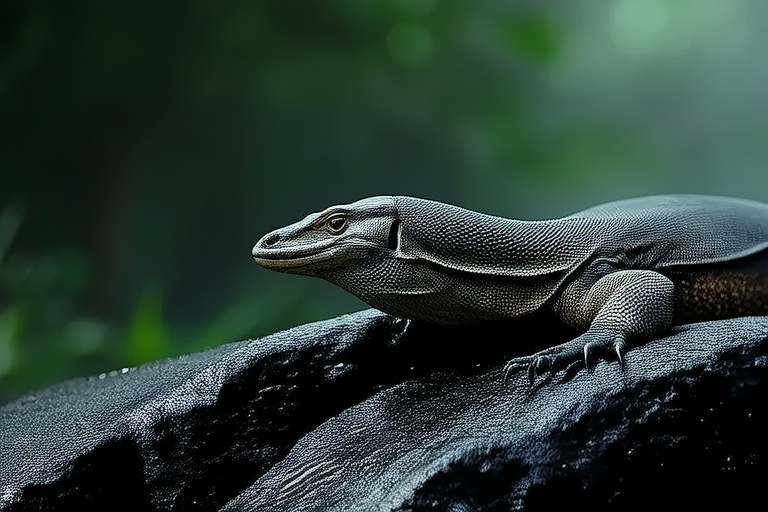Meet the Water Monitor: One of the Most Fascinating Reptiles to Keep as a Pet
The water monitor (Varanus salvator) is one of the most captivating reptiles that can be kept as a pet. Known for their agility, intelligence, and striking appearance, these creatures have a unique blend of traits that make them stand out among other reptiles. With their long tails, powerful limbs, and sharp claws, water monitors are built for both aquatic and terrestrial environments. This article will delve into the fascinating world of water monitors, covering their natural habitat, dietary needs, housing requirements, handling techniques, and health maintenance tips.
Natural Habitat and Dietary Needs
Water monitors are native to Southeast Asia, where they thrive in diverse habitats such as mangroves, forests, and riverbanks. They are semi-aquatic, spending time both on land and in water, making them well-adapted to a wide range of environmental conditions. In the wild, they feed on a variety of prey, including insects, small mammals, birds, and even fish. Their diet is highly adaptable, which is beneficial for captivity.
In captivity, it is essential to provide a balanced diet that mimics their natural feeding habits. Young water monitors should be fed daily, while adults can be fed every two to three days. A mix of appropriately sized rodents, feeder fish, and insects can satisfy their nutritional needs. It is crucial to offer a varied diet to ensure all necessary nutrients are provided. Additionally, supplements such as calcium and vitamin D3 should be used to prevent deficiencies.
Suitable Captive Environment
Creating an appropriate living space for a water monitor is vital for their well-being. These reptiles require a spacious enclosure that allows ample room for swimming, basking, and exploring. For juveniles, a 4x2x2-foot tank is sufficient, but adult water monitors need significantly more space, ideally a custom-built enclosure measuring at least 8x4x6 feet. The enclosure should include both dry land areas and a large water area, with a depth that allows the monitor to fully submerge.
Temperature control is another critical aspect of maintaining a healthy environment. Water monitors require a temperature gradient within their enclosure, with a basking spot reaching between 95 and 100 degrees Fahrenheit and cooler areas around 80 degrees. Proper humidity levels are also important, with a range of 70 to 80 percent being ideal. This can be achieved through misting, humidifiers, or water features within the enclosure.
Handling and Interaction
Handling a water monitor requires patience and care due to their strength and potential aggression. It is essential to approach the monitor slowly and gently, allowing it to become accustomed to your presence. Regular interaction helps build trust and reduces stress. Always support the body when handling, especially the tail, to avoid injury to both the monitor and the handler.
One of the most significant challenges for potential owners is the water monitor’s rapid growth. Juveniles can reach lengths of up to 3 feet within the first year, and adults can grow to over 6 feet. This growth rate necessitates continuous adjustments to the enclosure size and dietary requirements. Additionally, water monitors have strong jaws and sharp teeth, so proper handling techniques must be employed to minimize the risk of bites.
Health Maintenance and Signs of a Healthy Reptile
Maintaining the health of a water monitor involves regular veterinary check-ups, proper husbandry practices, and attentive observation. Common health issues include metabolic bone disease, respiratory infections, and parasites. Ensuring a balanced diet, adequate lighting, and clean water can help prevent many of these problems.
A healthy water monitor displays clear eyes, a robust appetite, and active behavior. Their skin should be smooth and free from lesions or discoloration. Regularly monitoring weight and overall body condition is crucial, as sudden changes may indicate underlying health issues. Additionally, keeping a close eye on fecal output can provide early warnings of digestive problems.
When seeking veterinary care, it is important to find a reptile-savvy veterinarian who understands the specific needs of water monitors. Routine check-ups, vaccinations, and preventative treatments are essential components of health maintenance. Owners should also familiarize themselves with basic first aid techniques and emergency procedures in case of unexpected injuries or illnesses.
Conclusion
The water monitor is a remarkable reptile that offers a unique and rewarding experience for those willing to meet the challenges of ownership. With their striking appearance, intelligence, and adaptability, they captivate both novice and experienced pet owners alike. By providing a suitable environment, meeting dietary needs, and engaging in regular interaction, owners can ensure the well-being of their water monitor. Remember, responsible ownership includes understanding the commitment required to care for these magnificent creatures properly. With the right care and attention, a water monitor can be a fascinating and beloved member of any household.
